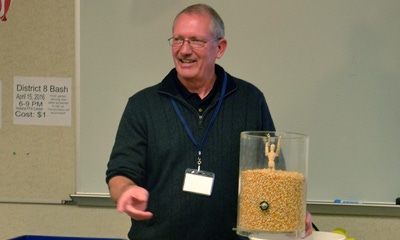
Local ag departments in Indiana have received calls recently from a major player in the grain industry looking for young people interested in pursuing a grain industry career. That’s a clear signal that there are positions available in an ag-related industry. What they need are young people interested in the industry. They’re willing to provide training.

TRAINED WORKERS IN DEMAND: Mike Manning provides training that helps potential young workers know how to work safely around grain operations.
Mike Manning is already starting the process by providing a certain part of the training — safety training — for high school and post-high school youth who are considering careers in the grain industry. Manning, working under the guidance of Bill Field, Purdue University Extension farm safety specialist, has spent more than two years training young people on how to work safely in confined spaces. That includes more than just in grain storage facilities.
Manning, a former county Extension educator and Extension director, came onboard when Purdue received a federal grant for the training. The grant has dried up, but Field is still funding his efforts because he knows there is a need.
Recently, we had the chance to see Manning in action at a training session. We also were able to ask him some questions about the need for training, and the program. Here are his answers.
IPF: How big is the grain industry in the U.S.?
Manning: There are over 14,000 commercial grain storage facilities in the country. These companies hire workers. There are another 300,000 farms where grain is stored on-site. It’s estimated that a million workers are involved in storing, handling and processing grain.
IPF: Why did you decide to do this job after stepping away from a successful career?
Manning: If I can save one life, then I feel like I’ve done my job. If I can save more than one life, then it’s that much better. There is a real need for training and education.
IPF: It seemed like the interest in training young workers has escalated over the past few years. Why is that?
Manning: Three teenage workers were involved in a commercial grain bin accident in an Illinois facility in 2012. Two died. It was the second day on the job for those boys. It raised a lot of eyebrows because they were not trained for what they were doing. It focused a lot of interest on the need for safety training for youth.
IPF: Why are younger workers at greater risk for grain bin engulfment and entrapment situations?
Manning: There are multiple reasons. They include a lack of training and experience, a lack of knowledge about the work they‘re being asked to do, the fact that younger people don’t yet have the ability to assess risk adequately — and many more.
IPF: Why is working in a confined space potentially dangerous?
Manning: The biggest risks are from asphyxiation and suffocation. If you’re working around manure pits, for example, the carbon dioxide can lead to asphyxiation. With grain bins and engulfment, the problem is often that you can’t get enough oxygen into the body due to the pressure of the grain.
IPF: Are there ways to know if a confined space has enough oxygen before you enter?
Manning: Yes. In larger facilities, one requirement is that you have a device with you to measure oxygen levels before you enter. Recommendations are that you don’t enter a space unless there is a minimum of 19% oxygen.
About the Author(s)
You May Also Like




